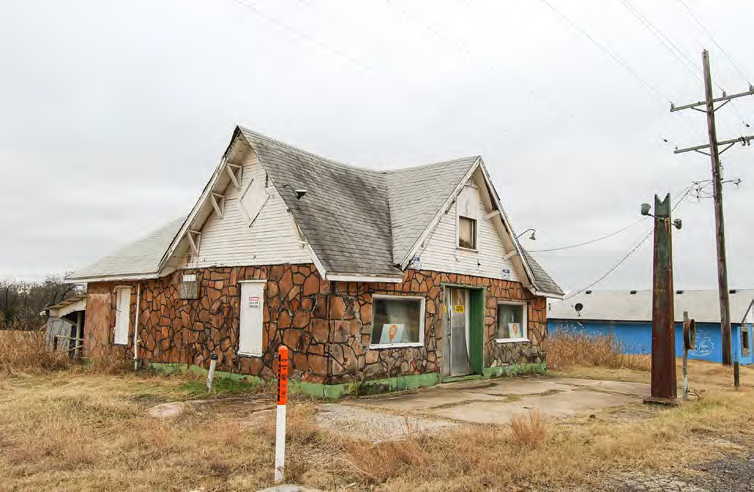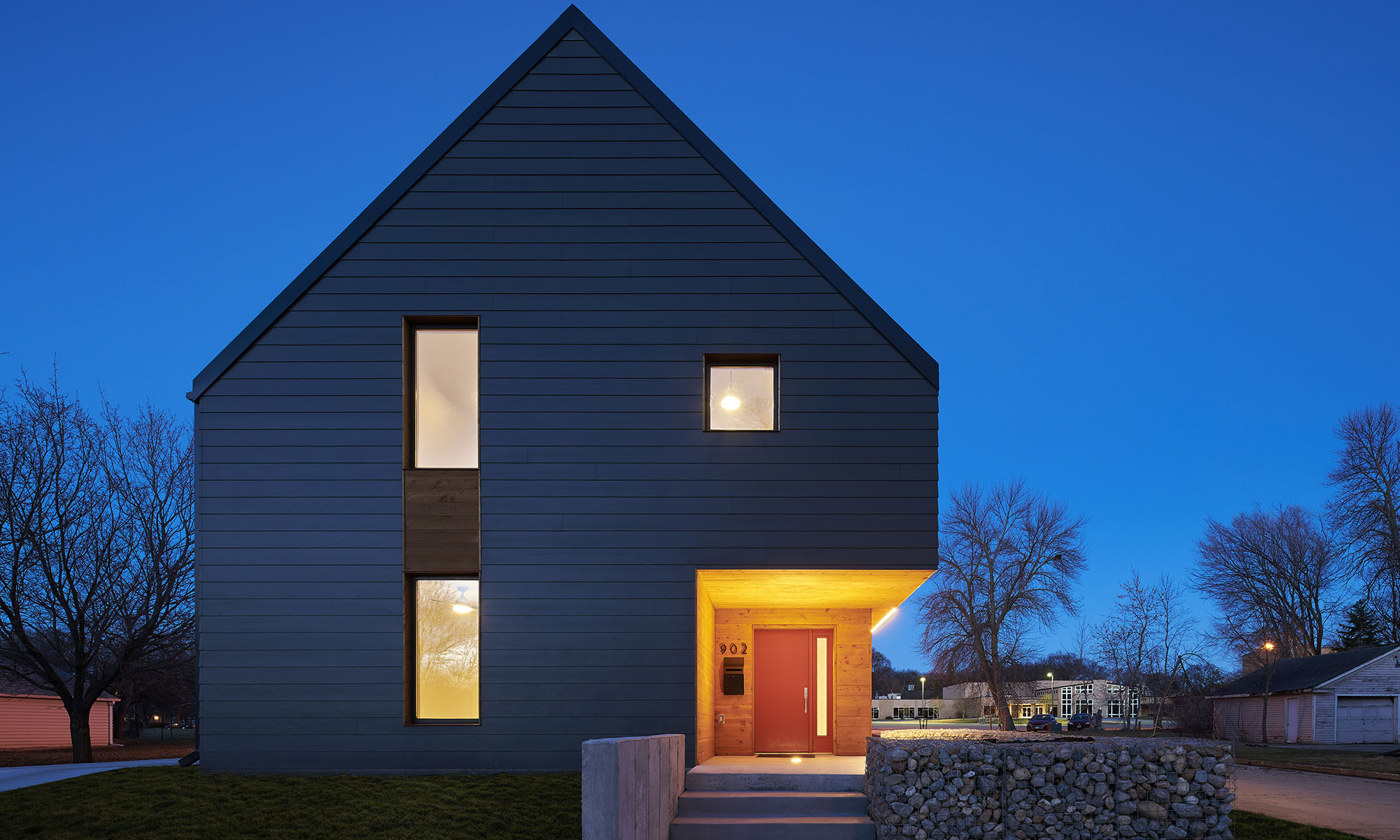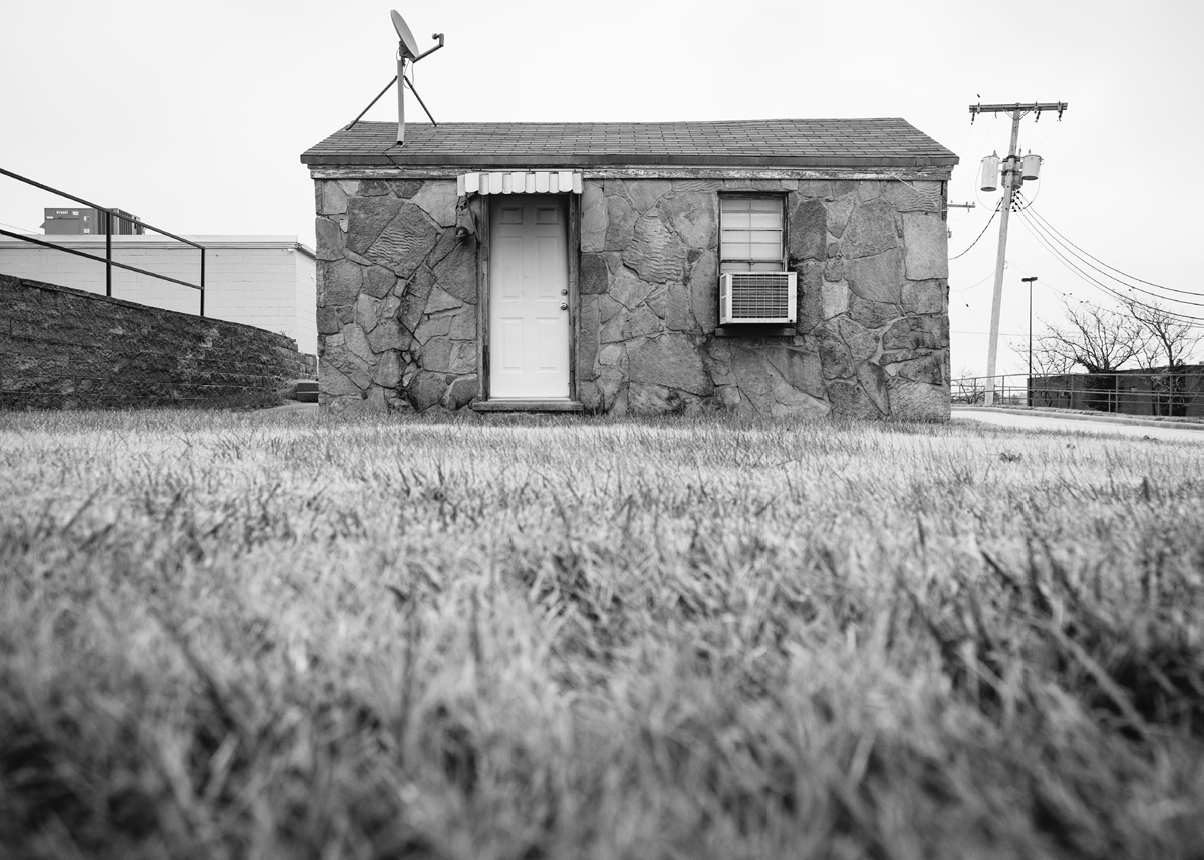The rural design community and CIRD look ahead by looking back.
Cover Photo: Sahar Coston-Hardy
Black-owned Graham’s Ribs in Springfield, Missouri, open from 1932 to 1996, was an establishment listed in the Negro Motorist Green Book
Originally published in Rural Voices – Cultivating Citizen-led Design Volume 24, No. 2, Fall 2020 by the Housing Assistance Council.
By Stephen Sugg and Alejandra Hardin
Jennifer Reut, the architectural historian behind the Mapping the Green Book project, is bullish on the potential of rural design—inclusive citizen-led rural design—to be a positive, unifying force as rural America becomes more diverse in an increasingly urbanized world. Reut knows the importance of architectural history, even when painful, as a grounding force when communities design for the future.
For Reut, who edits Landscape Architecture Magazine, “all places lived in constitute design.” She is keen on studying vernacular architecture, which encompasses ordinary buildings and landscapes crafted without the aid of trained architects. Reut emphasizes that non-architects designed the “near-entirety” of the landmarks in her ongoing study of the Negro Motorist Green Book and other travel guides. The study takes her to the remaining gas stations, beauty parlors, restaurants, hotels, and other establishments that served Black American travelers during the Jim Crow era, when their mere presence at non-vetted places could lead to mortal danger.
Lessons from history inform Reut’s advice to a rural design community seeking welcoming spaces where all rural Americans can thrive. Hint: it starts with listening.
CIRD’s conversations with Reut and other experts combine with a glimpse into rural architectural and design history in search of lessons to guide CIRD going forward. Rural design is a 23-year-old approach that makes connections between urban and rural futures, according to Dewey Thorbeck, whose work undergirds the discipline. Urban-centric outlooks permeate design scholarship and discourse.
As noted elsewhere in this issue of Rural Voices, the American Institute of Architects (AIA) is poised to soon elevate rural within the organization as attention to rural people and places is required for meeting challenges at the intersection of food security, climate, and inequality. Also pressing, HAC continues to emphasize the pandemic’s disproportionate economic impact on a rural America still lagging from the 2008-2009 Great Recession.
Historic preservation
The Great Depression offers a focal point for learning from past economic downturns with an eye on design. Non-white people bore the greatest burden of the Depression’s hard times, with the “last hired, first fired” mantra applying to the Black community— rural and urban. The federal response to the Depression included the Works Progress Administration (WPA) and the Public Works Administration investments in buildings and spaces with lasting impact, with a small slice of the federal arts and culture investment reaching the Black artistic community.
The rural rustic aesthetic emerged from the WPA’s influence, with plentiful examples remaining. Another example of federal investment in design with last impact is the Hall of Waters in Excelsior Springs, Missouri, a former health resort that incorporated Art Deco and Depression-era designs, as well as Mayan Water God motifs.
It is included on the National Trust for Historic Preservation’s 2020 “11 Most Endangered Historic Places” list and is in need of major repairs and upgrades for its current uses. Local leaders behind efforts to preserve the Hall of Waters are part of CIRD’s 2019-2020 Learning Cohort. The Public Works Administration’s $1 million investment in the building represents the agency’s most ambitious investment in Missouri. Those seeking to preserve the Hall hope for a tourist draw and downtown anchor rekindling the Hall’s role as a driver of the town’s economy, in addition to a source of civic pride.
Design that serves residents
Farmworkers have long faced low-wage labor in physically demanding and dangerous conditions in the fields and beyond. Recent reports of both COVID-19 and wildfires affecting farmworkers add yet another example. CIRD’s Alejandra Hardin spoke to Paul Chavez, President of the Cesar Chavez Foundation and youngest son of Cesar and Helen Chavez, seeking a historical frame for current events. “Unfortunately, while the pandemic is new, the hardships faced by farmworkers aren’t new,” Chavez said, adding that packed vans heading to fields and cramped housing conditions contribute to COVID-19’s rapid spread among farmworkers.
Ameliorating these conditions has driven his life’s work, carrying on a family tradition. Chavez said that while structures thwarting farmworkers’ participation in civic life and preventing access to services such as health care and education are ever-present, organizing and a holistic approach to meeting farmworker needs drive the foundation’s work.
One design-rooted example from Chavez: a retirement home for farmworkers built with communal dining, thus allowing Filipino farmworkers to enjoy traditional food in a familiar setting. Chavez also emphasized seeking the humanity of those enduring poverty, noting the powerful “hopes and dreams” of the less fortunate, even against long odds.
Inclusive public spaces
Jennifer Reut, like Paul Chavez, placed responses to COVID-19 in a historical context when asked for lessons going forward. She said that public spaces are more important as health conditions lead to increased outdoor gatherings, including in the rural American west where she lives part time. She has observed that affluent white people gather freely in parks and trails, for example, while people of color and/or immigrants are often “also there, but not as visible.” And thus, left out. She added that the Green Book was a tool for those “wanting to avoid humiliation.”
Making the design of these spaces inclusive would lead to public spaces truly for all—with the accompanying public health benefits. And that inclusive rural design can bring about truly accessible public spaces. Communities heeding Reut’s advice would be tapping history’s lessons for a better tomorrow.

Takeaways from Reut
Jennifer Reut’s conversation with CIRD offers some thoughts for practitioners to keep in mind. Rural America is not monolithic. “Every [rural] place is different.” Thus, it is difficult for design-focused publications to report on trends applicable to the rural architecture and design discipline. A shortage of reporters in rural America makes it difficult to access information organically, even if it is noteworthy to the broader design world.
It is also important to understand how the legacy of racism continues to hurt the Black community, so that practitioners can take action for a brighter future. Black history is often erased “purposefully.”
“There is much research on white towns and places,” she said, lamenting “the dearth of research on Black people, Black farms, and places.” Reut’s Mapping the Green Book work, beginning with a fellowship with the National Museum of African American History and Culture, underscores the Black community’s resilience while facing a system designed to suppress dreams of wealth and opportunity.
“So, they [Black communities] made business districts, schools, gathering places, and more…with an aim to allow the next generation to go to college.” Reut added that the Great Depression ensured that the Black community would be the “poorest of the poor without exception” as federal relief programs, with few exceptions, weren’t accessible to Black Americans— by design.

“Every school built, every Black business district is a form of resistance and resilience from the Black community,” she said, while noting a few remaining examples that her project has mapped. And though historians usually say 1968 marked Jim Crow’s unofficial end, Reut readily pointed out examples of redlining—government forced segregation of neighborhoods—occurring well after that year.

during Jim Crow. Photo Credit: Ernie Lowe.
History’s lessons, from architecturally significant structures that emerged from the New Deal to the nearly vanished establishments that once populated the Green Book for Black Motorists, provide grounding for rural design as a discipline. CIRD looks to heed such lessons while continuing to elevate best practices emerging from rural citizen-led design.
Rural resiliency remains a unifying force, past, present, and future.
Stephen Sugg is Special Projects Manager at HAC and Alejandra Hardin was a University of Chicago Institute of Politics Intern at HAC.
Allison Dvorak, AIA, CPHC, is a member of the AIA South Dakota Board of Directors, liaison to the Emerging Professionals and Communication committees, and an architect in Sioux Falls. She received her M.Arch from North Dakota State University and continues to develop her Master’s thesis of researching and implementing design theories focused on human centered design through speaking engagements, design practice, and one-on-one client education. Allison lives in Sioux Falls with her husband, son and daughter.


